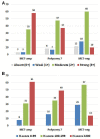MET Expression Level in Lung Adenocarcinoma Loosely Correlates with MET Copy Number Gain/Amplification and Is a Poor Predictor of Patient Outcome
- PMID: 35626038
- PMCID: PMC9139916
- DOI: 10.3390/cancers14102433
MET Expression Level in Lung Adenocarcinoma Loosely Correlates with MET Copy Number Gain/Amplification and Is a Poor Predictor of Patient Outcome
Abstract
MET amplification has been associated with shorter survival in cancer patients, however, the potential correlation of MET overexpression with either MET amplification or patient outcome is controversial. The aim of this study was to address these questions by correlating MET expression level with MET copy number and patient outcome in a cohort of 446 patients who had a lung adenocarcinoma: 88 with MET amplification, 118 with polysomy 7, and 240 with negative results by fluorescence in situ hybridization. MET expression assessed by immunohistochemistry was semi-quantified by expression level: absent (0+), weak (1+), moderate (2+) and strong (3+); or by H-score: 0-99, 100-199, and ≥200. MET expression level or H-score was positively but weakly correlated with MET copy number or MET/CEP7 ratio. Strong expression of MET (3+ or H-score ≥ 200) was associated with a shorter overall survival, but it was not an independent hazard for survival by multivariant analysis. We conclude that MET expression is loosely correlated with MET copy number gain/amplification. Strong expression of MET does not independently predict patient outcome.
Keywords: MET amplification; MET expression; lung cancer; survival.
Conflict of interest statement
The authors declare no conflict of interest.
Figures




References
-
- Frampton G.M., Ali S.M., Rosenzweig M., Chmielecki J., Lu X., Bauer T.M., Akimov M., Bufill J.A., Lee C., Jentz D., et al. Activation of MET via diverse exon 14 splicing alterations occurs in multiple tumor types and confers clinical sensitivity to MET inhibitors. Cancer Discov. 2015;5:850–859. doi: 10.1158/2159-8290.CD-15-0285. - DOI - PubMed
-
- Dagogo-Jack I., Yoda S., Lennerz J.K., Langenbucher A., Lin J.J., Rooney M.M., Prutisto-Chang K., Oh A., Adams N.A., Yeap B.Y., et al. MET Alterations Are a Recurring and Actionable Resistance Mechanism in ALK-Positive Lung Cancer. Clin. Cancer Res. 2020;26:2535–2545. doi: 10.1158/1078-0432.CCR-19-3906. - DOI - PMC - PubMed
-
- Wu Y.L., Zhang L., Kim D.W., Liu X., Lee D.H., Yang J.C., Ahn M.J., Vansteenkiste J.F., Su W.C., Felip E., et al. Phase Ib/II Study of Capmatinib (INC280) Plus Gefitinib After Failure of Epidermal Growth Factor Receptor (EGFR) Inhibitor Therapy in Patients With EGFR-Mutated, MET Factor-Dysregulated Non-Small-Cell Lung Cancer. J. Clin. Oncol. 2018;36:3101–3109. doi: 10.1200/JCO.2018.77.7326. - DOI - PubMed
LinkOut - more resources
Full Text Sources
Miscellaneous

